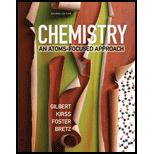
To find:
a. Write the net ionic equation.
b. Calculate
Answer to Problem 17.102QA
Solution:
a. The net ionic equation is:
b.
Explanation of Solution
1) Concept:
We are asked to write the net ionic equation for the
For the next part, we are asked to derive the
Referring to the
2) Formula:
i)
ii)
3) Given:
i) Silver polish contains aluminum powder in a basic suspension.
ii)
iii)
iv)
v)
4) Calculations:
a. Writing the net ionic equation from the overall reaction:
When silver sulphide reacts with aluminum, the following reaction takes place:
Since the reaction is taking place under atmospheric condition, water vapors from the atmosphere react with aluminum sulphide, giving us aluminum hydroxide. The reaction is
When we add the above reactions, we get the final reaction as
The reaction shows that the aluminum sulphide first formed reacts with the moisture in the environment to further form aluminum hydroxide.
Reaction (1) is only a redox reaction, whereas reaction (2) is just a displacement of ions. In reaction (2), the oxidation state of aluminum in
Overall reaction is
----------------------------------------------------------------
The net ionic equation can be written as
The number of electrons that are transferred in the above redox reaction is 3.
b. Calculating
The reaction involved in redox reaction is
Now, the anode half-reaction is written as
And, the cathode half-reaction is written as
The potential of the reaction can be calculated as
Now, the standard reduction potential of
Therefore, the potential of the reaction is
Referring Table A5.4, we get the
The
Calculating the equilibrium concentration for
Similarly, calculating the equilibrium concentration of
Conclusion:
Using the overall reaction, we can find out the net ionic equation as well as the
Want to see more full solutions like this?
Chapter 17 Solutions
CHEMISTRY:ATOMS-FOCUSED..-ACCESS
 ChemistryChemistryISBN:9781305957404Author:Steven S. Zumdahl, Susan A. Zumdahl, Donald J. DeCostePublisher:Cengage Learning
ChemistryChemistryISBN:9781305957404Author:Steven S. Zumdahl, Susan A. Zumdahl, Donald J. DeCostePublisher:Cengage Learning ChemistryChemistryISBN:9781259911156Author:Raymond Chang Dr., Jason Overby ProfessorPublisher:McGraw-Hill Education
ChemistryChemistryISBN:9781259911156Author:Raymond Chang Dr., Jason Overby ProfessorPublisher:McGraw-Hill Education Principles of Instrumental AnalysisChemistryISBN:9781305577213Author:Douglas A. Skoog, F. James Holler, Stanley R. CrouchPublisher:Cengage Learning
Principles of Instrumental AnalysisChemistryISBN:9781305577213Author:Douglas A. Skoog, F. James Holler, Stanley R. CrouchPublisher:Cengage Learning Organic ChemistryChemistryISBN:9780078021558Author:Janice Gorzynski Smith Dr.Publisher:McGraw-Hill Education
Organic ChemistryChemistryISBN:9780078021558Author:Janice Gorzynski Smith Dr.Publisher:McGraw-Hill Education Chemistry: Principles and ReactionsChemistryISBN:9781305079373Author:William L. Masterton, Cecile N. HurleyPublisher:Cengage Learning
Chemistry: Principles and ReactionsChemistryISBN:9781305079373Author:William L. Masterton, Cecile N. HurleyPublisher:Cengage Learning Elementary Principles of Chemical Processes, Bind...ChemistryISBN:9781118431221Author:Richard M. Felder, Ronald W. Rousseau, Lisa G. BullardPublisher:WILEY
Elementary Principles of Chemical Processes, Bind...ChemistryISBN:9781118431221Author:Richard M. Felder, Ronald W. Rousseau, Lisa G. BullardPublisher:WILEY





